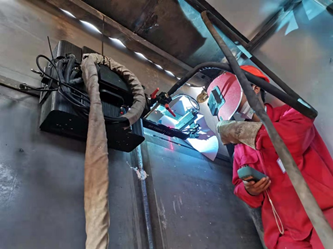Analyzing again the maintenance precautions of welding robots
Date:2021-10-12 Views:795
When intelligent technology is integrated into welding equipment, it presents a high-tech welding robot. Due to its high level of intelligence, the entire welding process can almost be completed automatically, greatly improving efficiency and welding accuracy. Even so, the failure rate cannot be completely zero. When a welding robot malfunctions, the first thing to do is to stop the machine for inspection and promptly eliminate the fault.

But considering the complexity of the welding robot system, it is still necessary to pay attention to some details during maintenance, otherwise there may be new problems that have not been fixed due to the original fault. The precautions for welding robot maintenance are as follows: Before starting to repair the welding robot, a detailed and comprehensive inspection of the entire equipment should be conducted to determine the location and cause of the fault.
Mainly check whether there is water or oil entering the electrical control box; Whether the electrical appliances are affected by moisture; Whether the power supply voltage meets the requirements; Whether the front and rear safety door switches are normal; Whether the rotation direction of the motor is consistent, etc. To repair a machine, it is necessary to first dismantle its components. When dismantling, it is important to remember to turn off the power supply first and also turn off the robot's air pressure source.
Then loosen the fixing screws of the cylinder fixing plate and move the arm to bring it closer; Move the buffer seat close to the arm; Tighten the fixing plate of the pulling cylinder to prevent the arm from moving; Locking the rotating safety screws to prevent the robotic arm from rotating, etc. These are all details that need to be noted. After troubleshooting in the welding robot, it is also necessary to install the parts that were just removed, and also pay attention to the installation sequence and position to maintain the integrity of the equipment.
When intelligent technology is integrated into welding equipment, it presents a high-tech welding robot. Due to its high level of intelligence, the entire welding process can almost be completed automatically, greatly improving efficiency and welding accuracy. Even so, the failure rate cannot be completely zero. When a welding robot malfunctions, the first thing to do is to stop the machine for inspection and promptly eliminate the fault.

But considering the complexity of the welding robot system, it is still necessary to pay attention to some details during maintenance, otherwise there may be new problems that have not been fixed due to the original fault. The precautions for welding robot maintenance are as follows: Before starting to repair the welding robot, a detailed and comprehensive inspection of the entire equipment should be conducted to determine the location and cause of the fault.
Mainly check whether there is water or oil entering the electrical control box; Whether the electrical appliances are affected by moisture; Whether the power supply voltage meets the requirements; Whether the front and rear safety door switches are normal; Whether the rotation direction of the motor is consistent, etc. To repair a machine, it is necessary to first dismantle its components. When dismantling, it is important to remember to turn off the power supply first and also turn off the robot's air pressure source.
Then loosen the fixing screws of the cylinder fixing plate and move the arm to bring it closer; Move the buffer seat close to the arm; Tighten the fixing plate of the pulling cylinder to prevent the arm from moving; Locking the rotating safety screws to prevent the robotic arm from rotating, etc. These are all details that need to be noted. After troubleshooting in the welding robot, it is also necessary to install the parts that were just removed, and also pay attention to the installation sequence and position to maintain the integrity of the equipment.











